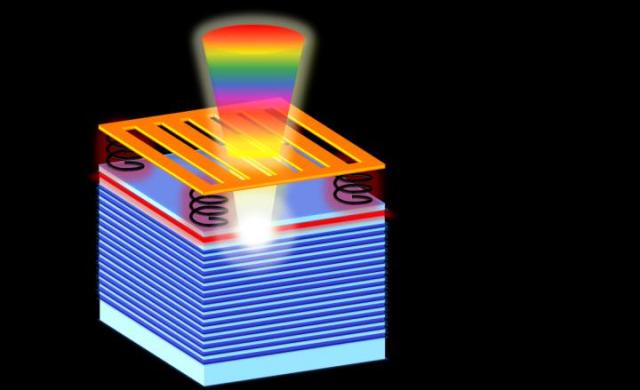Sep 4 2015
A new approach that uses light to move mirrors could usher in a new generation of laser technology for a wide range of applications, including remote sensing, self-driving car navigation and 3D biomedical imaging.
 This self-sweeping laser couples an optical field with the mechanical motion of a high-contrast grating (HCG) mirror. The HCG mirror is supported by mechanical springs connected to layers of semiconductor material. The red layer represents the laser's gain (for light amplification), and the blue layers form the system's second mirror. The force of the light causes the top mirror to vibrate at high speed. The vibration allows the laser to automatically change color as it scans. Credit: Schematic by Weijian Yang)
This self-sweeping laser couples an optical field with the mechanical motion of a high-contrast grating (HCG) mirror. The HCG mirror is supported by mechanical springs connected to layers of semiconductor material. The red layer represents the laser's gain (for light amplification), and the blue layers form the system's second mirror. The force of the light causes the top mirror to vibrate at high speed. The vibration allows the laser to automatically change color as it scans. Credit: Schematic by Weijian Yang)
A team of University of California, Berkeley, engineers led by Connie Chang-Hasnain, a professor of electrical engineering and computer sciences, used a novel concept to automate the way a light source changes its wavelength as it sweeps the surrounding landscape. They report their findings in the journal Scientific Reports, to be published Thursday, Sept. 3.
The advance could have implications for imaging technology using LIDAR, or light detection and ranging, and OCT, or optical coherence tomography.
"Our paper describes a fast, self-sweeping laser that can dramatically reduce the power consumption, size, weight and cost of LIDAR and OCT devices on the market today," said Chang-Hasnain, chair of the Nanoscale Science and Engineering Graduate Group at UC Berkeley. "The advance could shrink components that now take up the space of a shoebox down to something compact and lightweight enough for smartphones or small UAVs [unmanned aerial vehicles]."
LIDAR works by shining a beam of light at a target and measuring the amount of time it takes to bounce back. Because the speed of light is constant, this system can then be used to calculate distance. Self-driving vehicles and remote sensing technology use LIDAR for navigation and the creation of 3D maps.
OCT applies the same principle of measurement to the scale of millimeters in medical imaging. The technology is used to create cross-sectional images of the retina and help with the early detection of retinal diseases, including age-related macular degeneration.
Moving mirrors with light
In both applications, as the laser moves along, it must continuously change its frequency so that it can calculate the difference between the incoming, reflected light and the outgoing light. To change the frequency, at least one of the two mirrors in the laser cavity must move precisely.
"The mechanisms needed to control the mirrors are a part of what makes current LIDAR and OCT systems bulky, power-hungry, slow and complex," said study lead author Weijian Yang, who did this work as a UC Berkeley Ph.D. student in electrical engineering and computer sciences. "The faster the system must perform - such as in self-driving vehicles that must avoid collisions - the more power it needs."
The novelty of the new design is the integration of the semiconductor laser with the mirror. Each laser can be as small as a few hundred micrometers square, and it can be readily powered by an AA battery.
The coupling of the laser with an ultra-thin, high-contrast grating (HCG) mirror allowed the researchers to harness the physical force of the light to move the mirror. The HCG mirror, consisting of rows of tiny ridges, was developed in Chang-Hasnain's lab and has recently been used to create an artificial, chameleon-like skin. With an average force of just a few nanonewtons, or about one-thousandth the weight of an ant, the light exerts enough energy to cause the mirror to vibrate.
'Like a kid on a swing'
"The light acts like a kid on a swing, and the mirror is the swing itself," said Yang, who is now a postdoctoral researcher in biological sciences at Columbia University. "If the child moves his body properly along the swinging path, he can enjoy this 'free' ride without any external force. This is what is happening in this self-sweeping laser."
In their experiments, the researchers found that this optomechanical interaction of the laser and the mirror can sweep across a wavelength range of more than 23 nanometers in the infrared spectrum without the need for external controls.
"That wavelength range would be sufficient for a system that could resolve 50-micrometer surface profile features, even when the target is tens of meters away," said study co-author Adair Gerke, a Ph.D. student in Chang-Hasnain's group.
Moreover, the period of the sweeping cycle can be as short as a few hundred nanoseconds, enabling several million sweeps per second. This speedy sweeping rate enables 3D image capture for real-time videos and visualization of depth change.
The study authors said the next stage of the research will be to incorporate this new laser design in current LIDAR or OCT systems, and to demonstrate its application in 3D video imaging.